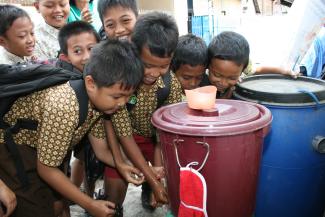Maternal and Child Health Investments, FY16: $20,000,000
Indonesia Quick Facts: Water, Sanitation and Hygiene
68 percent reduction in child mortality, 1990-20151
2,246,005 people reached by USAID with improved drinking water and 256,055 with improved sanitation, 2011-20152
Ministerial regulation for community-based total sanitation issued in 2014 with USAID support3
Increase in access to sanitation facilities from 35 to 61 percent, 1990-20154
Today, 2.4 billion people -- a third of the world’s population -- lack access to adequate sanitation. Forty percent of the world’s population uses unsafe toilets or practices open defecation, increasing the risk of infection, diseases and, in the case of women and girls, rape and abuse.5 In Indonesia, one in three people does not have access to a flush toilet, latrine or septic system.
Nurita, a grandmother of two from Indonesia’s Banten province, used to worry about the safety of her grandchildren, who lacked regular access to a toilet and often had to defecate in open fields.6 She knew the dangers of open defecation, and feared for her own safety as well, especially at night.
Through an innovative microfinance program, supported by USAID, Nurita received a loan to construct a new toilet for her family. Completed two months ago, the latrine is connected to a toilet system, and has given Nurita a peace of mind that she hadn’t had before.
“I feel more comfortable inviting guests to visit and feel safe while using the toilet at night,” she says.
The project involves a partnership with a local cooperative that provides microfinance services to local families and small business-owners so that they can build safe and hygienic bathroom facilities. In addition to providing loans to local families, USAID has also trained and developed small-scale construction contractors in system use, maintenance and repair. This ensures that the toilet will remain a sustainable, safe addition to Nurita’s home.
WASH FOR HEALTH
With the support of USAID and others, access to adequate water, sanitation and hygiene (WASH) services are improving throughout Indonesia. Over the past 25 years, the rate of access to sanitation facilities has nearly doubled across the country, increasing from 35 percent in 1990 to 61 percent in 2015.7
During Fiscal Year (FY) 2015, USAID helped more than 2.2 million people gain access to an improved water supply and more than 250,000 people with improved sanitation services in Indonesia.8
Expanding and improving WASH services is an important component of USAID’s efforts to end preventable child and maternal deaths worldwide. Improving health outcomes through sustainable WASH is one of two strategic objectives of USAID’s 2013–2018 Water and Development Strategy, which aims to save lives and advance development through improvements in water supply, sanitation and hygiene programs and through the sound management and use of water for food security.9 In FY 2015 alone, the U.S. Agency for International Development (USAID) helped 2.3 million people worldwide gain access to improved sanitation.
Our work in Indonesia demonstrates the importance of WASH interventions and their potential to save and improve the lives of individuals and families. In the 2014 Acting on the Call Report, USAID formulated a roadmap for making data-driven decisions and targeted investments, like WASH, to save the lives of 15 million children and 600,000 women by 2020.10 In Indonesia, scaling up high impact practices could save the lives of 382,000 children under-5 and 31,000 women by 2020.11
By providing sustainable access to safe sanitation, USAID is improving the health of women and children while creating opportunities for the community. Our efforts to end preventable child and maternal deaths are invaluable contributions towards our vision of a more secure and prosperous world free of extreme poverty.
Meet more of the women and children that benefit from USAID's efforts.
« Back to the Acting on the Call home page
1 Levels and Trends in Child Mortality: Report 2015. UNICEF, September 2015.
2 USAID Indonesia Urban Water Sanitation and Hygiene Annual Progress Report 5: October 2014 - September 2015. USAID, November 2015.
3 Acting on the Call: Ending Preventable Child and Maternal Deaths. USAID, June 2015.
4 USAID Indonesia Urban Water Sanitation and Hygiene Annual Progress Report 5: October 2014 - September 2015. USAID, November 2015.
5 Water and Development Strategy 2013-2018. USAID, 2013.
6 “Loans Bring Toilets, Sanitation to Indonesia.” USAID Transforming Lives, November 2015.
7 USAID Indonesia Urban Water Sanitation and Hygiene Annual Progress Report 5: October 2014 - September 2015. USAID, November 2015.
8 Ibid.
9 Water and Development Strategy 2013-2018. USAID, 2013.
10 Acting on the Call: Ending Preventable Child and Maternal Deaths. USAID, June 2014.
11 Acting on the Call: Ending Preventable Child and Maternal Deaths. USAID, June 2015.

USAID Indonesia
